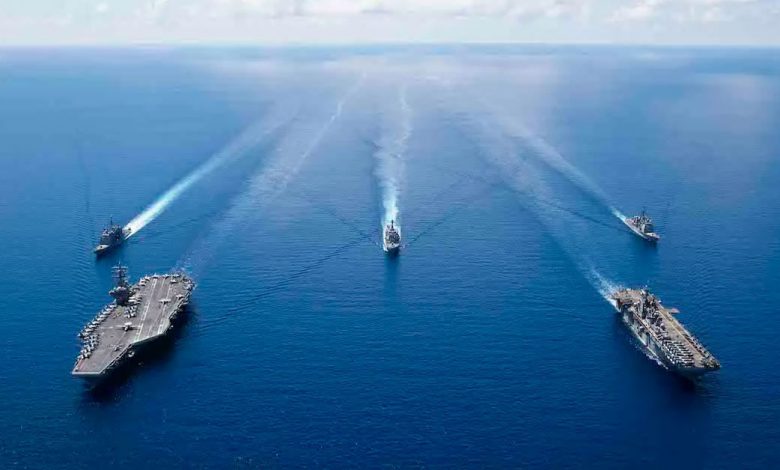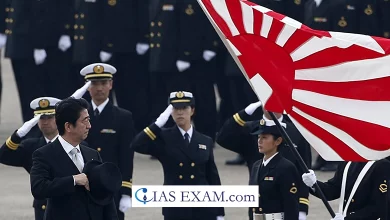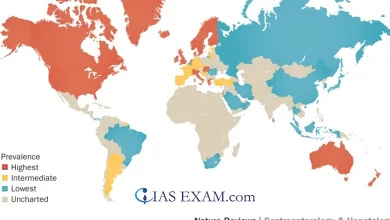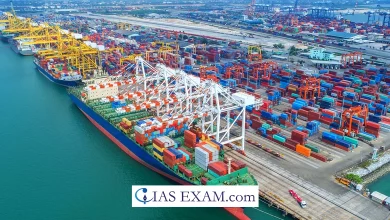
Context- For the past ten years, China has maintained its claims to a substantial portion of the South China Sea.
Key Highlights
- Location of the South China Sea:
-
-
- It is surrounded on the east by Taiwan and the Philippines, on the northeast by the Taiwan Strait, which connects it to the East China Sea.
- on Borneo’s southeast and south, the Gulf of Thailand’s southern limit, and the Malay Peninsula’s east coast; and the Asian mainland to the north and west.
-
- Regarding the dispute:
-
-
- For centuries, Southeast Asian nations such as China, Vietnam, the Philippines, Brunei, Malaysia, and Taiwan have fought over the tense South China Sea region.
- The two primary disagreements are as follows:
- In the water, the Spratly and Paracel Islands.
-
- Nine-dash line
-
-
-
- The U-shaped “nine-dash line,” which encompasses as much as 90% of these waters, is at the center of Beijing’s claim to the majority of the region.
- In the 1940s, Chinese maps were used to draw this dotted line, which represents Beijing’s claim to the sea and all of its land features.
-
-
- Significance of the area:
-
- The South China Sea (SCS) is important for more than just the countries on its coast.
- It is a repository for mineral deposits and hydrocarbon reserves, has been a transit point for trade since the early medieval period, and has abundantly rich fisheries.
China’s dominance in the region
-
- Some Chinese officials refer to the South China Sea as the country’s “blue national soil,” a term used to refer to the country’s offshore waters.
- China currently asserts “indisputable sovereignty” over the region.
- According to the Chinese and Taiwanese, each dash on the nine-dash line represents the median line between the islands in the South China Sea and the large landmasses that make up the littorals of the sea.
- In the SCS, Chinese muscularity is growing in the following ways:
-
-
- Chinese naval vessels’ increased patrolling and live-fire training;
- rming and sinking of fishing boats from other countries that are claimants;
- renaming of SCS capabilities; and the construction of runways, bunkers, and a home for personnel who might be stationed there for a long time on the atolls China claims.
- Chinese exploration and drilling vessels contend forcefully with those of other littoral nations in the contested waters.
-
- New Maritime Law from China
-
- China announced new maritime regulations requiring vessels to report information while traveling through what it considers to be its “territorial waters” in an effort to regulate foreign vessels.
- Upon their visits to Chinese territorial waters, operators of submersibles, nuclear vessels, ships carrying radioactive materials, ships carrying bulk oil, chemicals, liquefied gas, and other toxic and harmful substances are required to report their detailed information.
UNCLOS’ Tribunal verdict
-
- China’s historic rights claim over maritime areas (as opposed to land territories and territorial waters) within the nine-dash line has no legal effect if it exceeds what it is entitled to under the UNCLOS, according to the 2016 verdict of an arbitral tribunal established under the UNCLOS in The Hague.
- It ruled that the Spratlys lacked the characteristics necessary to be considered islands, and there was no legal basis for China’s claim to historic rights and resources within the “nine-dash line.”
- The award suggested that China broke the Exclusive Economic Zone (EEZ) of the Philippines.
- It noted that China had violated its obligation to preserve the ecosystem and had aggravated the situation by carrying out land reclamation and construction.
- China’s rejection of the veto:
-
- The award was described by China as “a political farce under the pretext of law.”
Options for settlement for the nations around it
- Because of the power balance, no country challenged China, which agreed to settle disputes bilaterally and continue working on a Code of Conduct with ASEAN nations.
- The nations are seeking political insurance, bolstering their navies, and deepening their military ties with the United States while avoiding a military confrontation with China.
Options for India and the way out
-
- The SCS ships goods to and from India. As a result, India and China both have stakes in the South China Sea (SCS).
- Strategic alliances and defense diplomacy:
-
-
- In the Indo-Pacific region, India must continue to actively pursue its defense diplomacy outreach:
- Extend humanitarian assistance and disaster relief efforts,
- share Malacca Strait patrolling with littoral nations,
- increase military training, conduct more complex exercises and exchanges, etc.
- Malaysia, the Philippines, Thailand, and Singapore could be included in the Comprehensive Strategic Partnerships that India has established with Australia, Japan, Indonesia, the United States, and Vietnam.
- In the Indo-Pacific region, India must continue to actively pursue its defense diplomacy outreach:
-
- Enhancing Andaman and Nicobar military capabilities:
-
- India must also support the tri-service Andaman and Nicobar Command’s military power.
- Because they overlook Asia’s maritime strategic lifeline and the world’s most significant global sea lane, these have enormous geostrategic value.
- India cannot afford to continue undervaluing one of its largest assets during this turbulent time.
Convention of the United Nations on the Law of the Sea (UNCLOS)
- The UNCLOS is a treaty that was ratified and ratified internationally in 1982.
- It took the place of the four Geneva Conventions that were signed in April 1958 and dealt with the territorial sea and the contiguous zone, the continental shelf, the high seas, fishing, and protecting living resources on the high seas.
- The Convention has established three brand-new international institutions:
- the International Tribunal for the Laws of the Sea, the International Seabed Authority, and the Commission on the Limits of the Continental Shelf Exclusive Economic Zone (EEZ) In accordance with the Law of the Sea Convention, each state has the right to a 200-nautical-mile Exclusive Economic Zone (EEZ) to exploit the sea’s resources and seabed from their land territories.
- Countries are obligated to negotiate with other claimants where these zones overlap.





.png)



